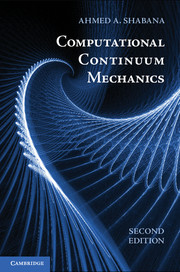Book contents
- Frontmatter
- Contents
- Preface
- 1 Introduction
- 2 Kinematics
- 3 Forces and Stresses
- 4 Constitutive Equations
- 5 Plasticity Formulations
- 6 Finite Element Formulation: Large-Deformation, Large-Rotation Problem
- 7 Finite Element Formulation: Small-Deformation, Large-Rotation Problem
- 8 Computational Geometry and Finite Element Analysis
- References
- Index
8 - Computational Geometry and Finite Element Analysis
Published online by Cambridge University Press: 05 June 2012
- Frontmatter
- Contents
- Preface
- 1 Introduction
- 2 Kinematics
- 3 Forces and Stresses
- 4 Constitutive Equations
- 5 Plasticity Formulations
- 6 Finite Element Formulation: Large-Deformation, Large-Rotation Problem
- 7 Finite Element Formulation: Small-Deformation, Large-Rotation Problem
- 8 Computational Geometry and Finite Element Analysis
- References
- Index
Summary
Computational geometry methods such as Bezier, B-spline, and Non-Uniform Rational B-Splines (NURBS) are widely used in the design of engineering and physics systems (Dierckx, 1993; Farin, 1999; Piegl and Tiller, 1997; Rogers, 2001). At the design stage, the geometry of the systems is defined using computer-aided design (CAD) software. The CAD models then are converted to a finite element (FE) mesh to perform the analysis to determine deformations, stresses, and forces as the result of the applied loads. CAD systems use computational geometry methods that accurately define complex shapes and allow for efficient shape manipulation. These methods have many desirable features and share many of the properties required for the development of accurate analysis methods. Nonetheless, computational geometry methods are used primarily for the system geometric construction.
Because of the limitations of existing FE formulations and the fact that the geometric (i.e., kinematic) descriptions used in them are not equivalent to the geometric description used in CAD systems, there is a recent trend to use computational geometry methods as analysis tools. Although both FE and computational geometry methods are based on polynomial representations, many of the existing FE formulations distort the geometry because of the nature of the nodal coordinates selected. As a result, the geometry of the FE mesh used in the analysis can be different from the geometry defined in the CAD systems. This inconsistency makes the conversion of the CAD model to an analysis model difficult and costly and leads to analysis models that are not consistent with the CAD-geometry models. The two FE formulations discussed in Chapters 6 and 7 were developed to address and remedy this problem. The two formulations can be used as the basis for a successful integration of computer-aided design and analysis (I-CAD-A).
Information
- Type
- Chapter
- Information
- Computational Continuum Mechanics , pp. 296 - 312Publisher: Cambridge University PressPrint publication year: 2011
